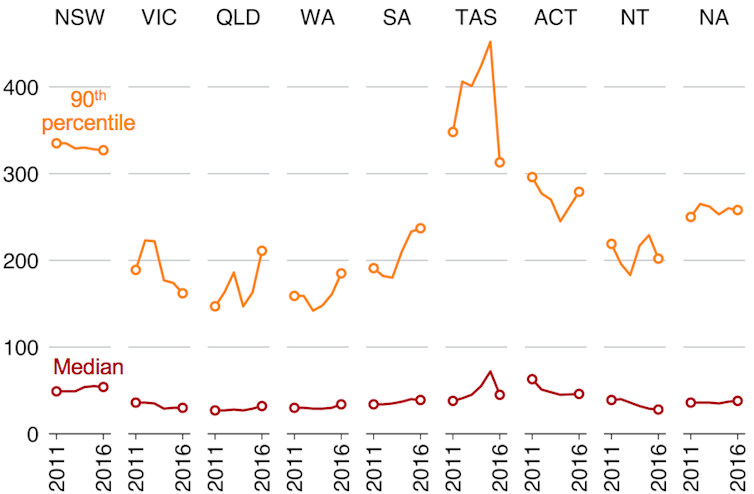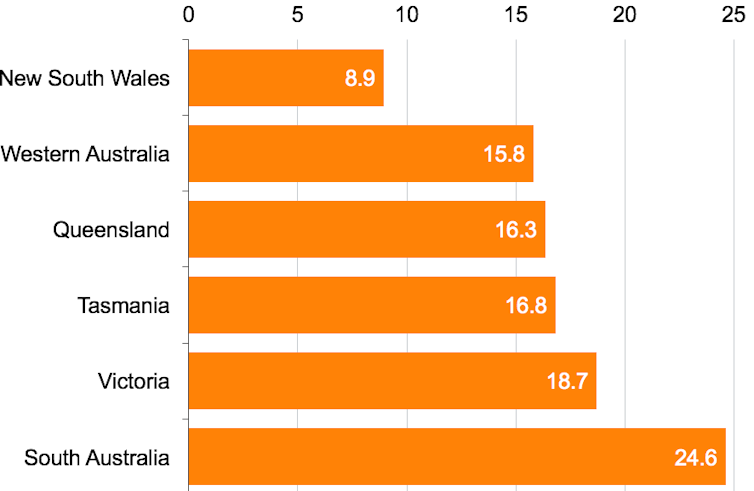This week we’re exploring 9 other coverage spaces throughout Australia’s states, as detailed in Grattan Institute’s State Orange Guide 2018. Learn the opposite articles within the sequence right here.
Australia has a just right fitness device by way of world requirements, but it surely has to recuperate. Part of all sufferers throughout Australia wait greater than a month for an optionally available sanatorium process, akin to a hip substitute. That is along with looking forward to an outpatient consult with so they are able to be added to the optionally available process wait record.
“Non-obligatory” right here doesn’t imply the affected person can do with out the process – they could also be in ache or having bother transferring round whilst ready. Non-obligatory merely way it doesn’t should be completed straight away and can also be scheduled.
Learn extra:
To stay sufferers secure in hospitals, the accreditation device wishes an overhaul
About 9% of other folks in New South Wales and about 25% in South Australia wait greater than a 12 months for public dental services and products, akin to fillings, extractions and root canals.
Physicians document just about one-third of sufferers with an acute psychological sickness wait greater than 8 hours in sanatorium emergency departments.
The Grattan Institute’s State Orange Guide 2018 charts the efficiency, maps a path to development, and recommends consequences for states that fail to satisfy ready record goals.
Contents
Why hospitals are at all times key state election problems
Well being is the biggest unmarried element of state govt expenditure in each and every state of Australia, and has been rising unexpectedly. About two-thirds of state govt fitness spending – except for transfers from the Commonwealth – is on public hospitals.
Simply over part the inhabitants does no longer have medical insurance and so is dependent upon public hospitals for all their care. Even for other folks with non-public insurance coverage, public hospitals are their most important supply of emergency care.

Annette Shaff/Shutterstock
State governments are answerable for public hospitals, so sanatorium care is at all times a key factor in state elections. It’s subsequently no marvel state governments like to let us know how a lot they’re doing for public hospitals, and election campaigns are frequently jam-packed with guarantees of recent or expanded hospitals.
The politicians, a minimum of in states with rising populations, are proper that extra beds are wanted. What issues for the general public, although, isn’t what number of beds there are, however whether or not there are sufficient. A method of measuring this is ready instances, and right here the image isn’t as rosy as campaigning politicians would really like us to consider.
Looking ahead to optionally available sanatorium procedures
It’s dangerous sufficient part of all sufferers throughout Australia wait greater than a month for an optionally available process from the time they had been booked. What’s worse is that about 10% wait greater than six months.
In our smallest state, Tasmania, 10% of sufferers wait a few 12 months. Within the largest state, NSW, the placement is sort of as dangerous.
This graph displays the ready time (days) for optionally available procedures, 2012-13 to 2016-17, for the ten% of sufferers who wait longest (orange) and the median (maroon):

Grattan Institute/Australian Institute of Well being and Welfare
Publicly reported knowledge focal point on optionally available process or optionally available surgical operation ready instances, however there may be every other necessary wait: from the time a affected person is referred to the sanatorium to the time they’re observed in an outpatient medical institution. That is often referred to as the “hidden ready record”.
Learn extra:
Getting an preliminary experts’ appointment is the hidden waitlist
For the affected person, the stay up for an appointment with an outpatient medical institution issues – it delays analysis and remedy. But those waits aren’t publicly reported in NSW, Western Australia, the Australian Capital Territory or the Northern Territory. And the states that do document outpatient medical institution wait instances don’t use constant measures.
Our state and territory governments must fortify sanatorium duty to cut back mixed outpatient and inpatient ready instances. There must be transparent penalties and consequences for failure to satisfy goals.

Shutterstock/cvm
Looking ahead to public dental care
The COAG Well being Council (made up of Commonwealth, state and territory fitness officers) says present investment for public dental services and products lets in for remedy of best about 20% of the eligible inhabitants.
The remainder 80% must stay up for lengthy sessions, pay for reasonably dear care within the non-public sector, or cross with out care completely.
Ready instances range considerably amongst states. And in different states, significantly Vic and SA, ready instances have were given longer lately.
Boosting public dental services and products will give a boost to other folks’s fitness and scale back the tension on hospitals.
In 2015-16, there have been 67,266 sanatorium admissions for probably preventable dental stipulations – greater than one-fifth of all sanatorium admissions for probably preventable acute stipulations.
Learn extra:
Deficient and aged Australians let down by way of unwell number one fitness device
Unforgivably, our state governments have no longer delivered on a 2012 dedication to observe ready instances for public dental care via a Nationwide Healthcare Settlement efficiency indicator. Information inconsistencies imply it’s no longer imaginable to reliably evaluate public dental ready lists throughout states and territories.
NSW does no longer supply knowledge on public dental ready lists in any respect, mentioning issues about the opportunity of deceptive comparisons. The one related knowledge we now have is from an Australian Bureau of Statistics pattern survey, which displays greater than 10% of sufferers around the nation wait greater than a 12 months for public dental care.
This graph displays the percentage of people that waited greater than a 12 months for public dental services and products:

Grattan Institute/Australian Bureau of Statistics
Looking ahead to psychological fitness care
Campaigners say Australia has reached a “tipping level” on get right of entry to to psychological fitness care. Physicians document just about one-third of sufferers with an acute psychological sickness wait greater than 8 hours in emergency departments.
We all know this does harm: lengthy waits for get right of entry to to group psychological fitness services and products can lead to poorer results for sufferers, as a situation could also be more difficult to keep watch over the longer it persists. Lengthy waits may additionally position further force on households or buddies who face the results in their pal or circle of relatives member’s behaviour.
But there’s no details about the adequacy of group psychological fitness services and products in Australia. The 2017 Nationwide Psychological Well being and Suicide Prevention Plan best tracks using services and products, no longer their adequacy.
Learn extra:
Extra Australians can keep more fit and out of sanatorium – here is how
By contrast, Canadian governments have agreed {that a} wide selection of psychological fitness and addictions signs can be amassed and reported from 2019.
Australian electorate must call for their state governments do the similar factor. We must wait now not for a greater fitness device.
Supply Via https://theconversation.com/waiting-for-better-care-why-australias-hospitals-and-health-care-are-failing-104862



